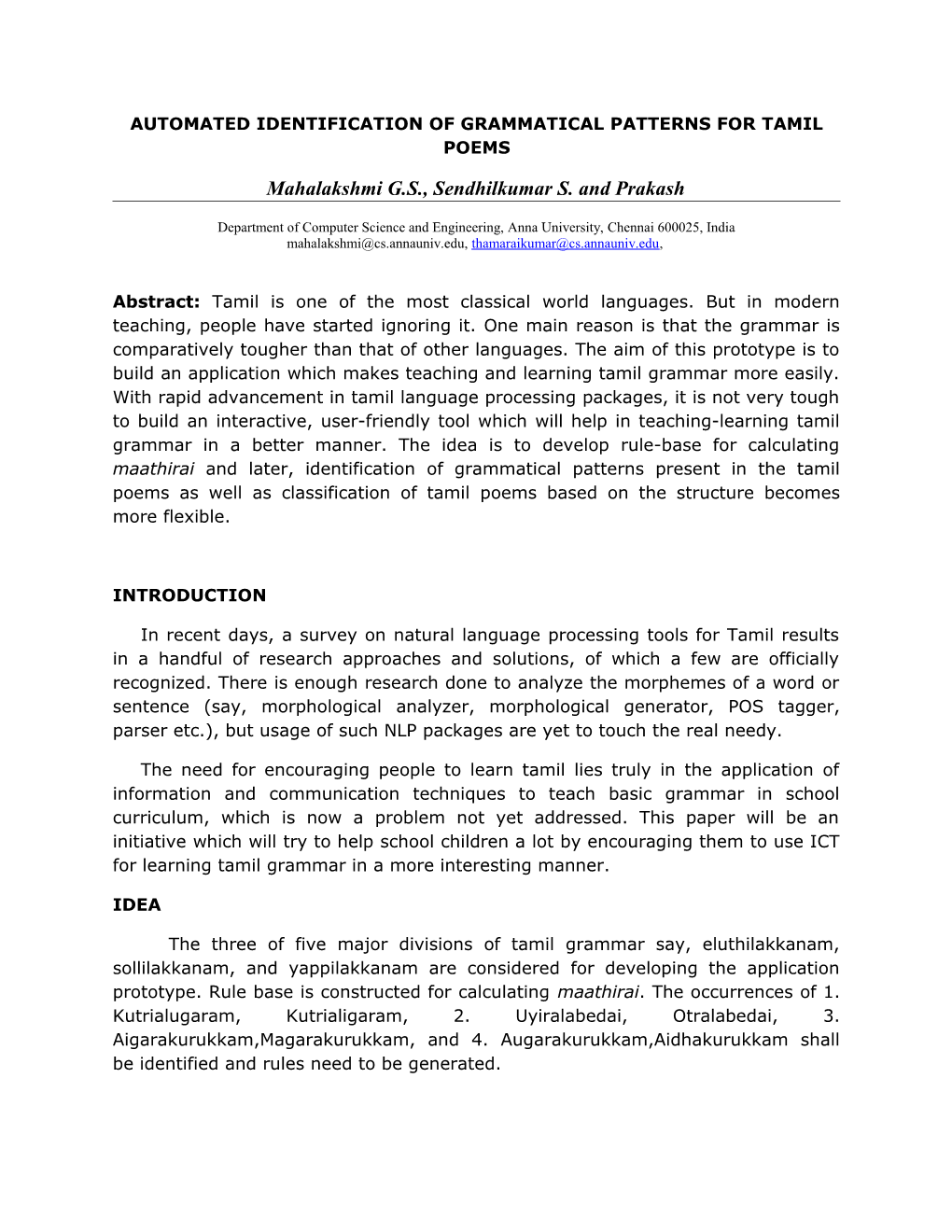AUTOMATED IDENTIFICATION OF GRAMMATICAL PATTERNS FOR TAMIL POEMS
Mahalakshmi G.S., Sendhilkumar S. and Prakash
Department of Computer Science and Engineering,Anna University, Chennai 600025, India
, ,
Abstract:Tamil is one of the most classical world languages. But in modern teaching, people have started ignoring it. One main reason is that the grammar is comparatively tougher than that of other languages.The aim of this prototype is to build an application which makes teaching and learning tamil grammar more easily. With rapid advancement in tamil language processing packages, it is not very tough to build an interactive, user-friendly tool which will help in teaching-learning tamil grammar in a better manner. The idea is to develop rule-base for calculating maathirai and later, identification of grammatical patterns present in the tamil poems as well as classification of tamil poems based on the structure becomes more flexible.
INTRODUCTION
In recent days, a survey on natural language processing tools for Tamil results in a handful of research approaches and solutions, of which a few are officially recognized. There is enough research done to analyze the morphemes of a word or sentence (say, morphological analyzer, morphological generator, POS tagger, parser etc.), but usage of such NLP packages are yet to touch the real needy.
The need for encouraging people to learn tamil lies truly in the application of information and communication techniques to teach basic grammar in school curriculum, which is now a problem not yet addressed. This paper will be an initiative which will try to help school children a lot by encouraging them to use ICT for learning tamil grammar in a more interesting manner.
IDEA
The three of five major divisions of tamil grammar say, eluthilakkanam, sollilakkanam, and yappilakkanam are considered for developing the application prototype. Rule base is constructed for calculating maathirai. The occurrences of 1. Kutrialugaram, Kutrialigaram, 2. Uyiralabedai, Otralabedai, 3. Aigarakurukkam,Magarakurukkam, and 4. Augarakurukkam,Aidhakurukkam shall be identified and rules need to be generated.
In addition, the classification of poems (into Venba, Asiriappa, Kalippa and Vanjippa) based on their structure shall be done using the maathirai calculation. Adding to that,rule base can be created to find the presence of various grammatical items including
Ezhuththu (kuril, nedil, aidham)
Asai (naer, nirai)
Seer (4 types which have several sub types)
Thalai (7 types)
Adi (5 types)
Thodai (edhugai, monai, muran, iyaibu)
The existing morphological analysers [2] addressesSollilakkanamin a decent manner. Utilizing the morphological analyser, in this prototype, we shall also try a hand at some of the things including
- Pagupadha Urupilakkanam
- Ilakkana Kurippu (like Adukku thodar)
- Sol vagaigal (using a dictionary)
CONCLUSION
While utmost care has been taken to develop the grammar prototype in Unicode, it is no doubt that automatic identification of grammatical patterns is going to be a worthy application with respect to school education. Porulilakkanam and ani ilakkanam deal with the semantics of the language. With decent tamil dictionaries like agaradhi [1], handling Porulilakkanam is not an issue. However, ani ilakkanam requires enough research thought to be thrown before things could be materialized. But, times are not too far that in future, using tamil NLP tools, one should be able to analyse the similes present in the input tamil text.
REFERENCES
